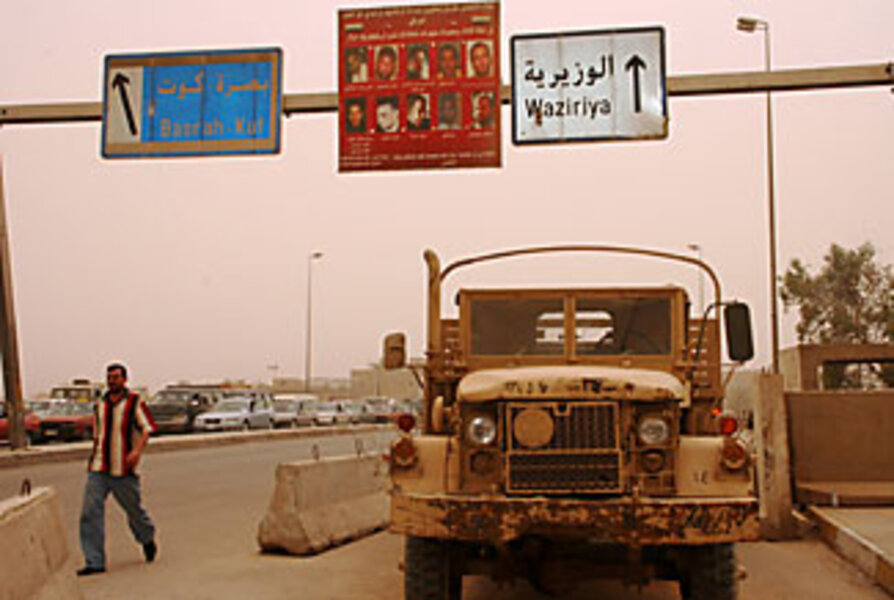Sadr City blast reveals new dangers for U.S.
Loading...
| Baghdad
The brazen Tuesday morning bombing occurred in an Iraqi municipal council building within the section of Moqtada al-Sadr's Shiite stronghold of Sadr City that is sealed off and guarded by American and Iraqi forces.
While the US military has so far said little about how the explosives were planted inside the building, the few details that have emerged reveal that the strike, which killed at least four Americans and six Iraqis, was well coordinated and timed. It struck about 9:30 a.m. just as local officials who are cooperating with the US gathered to elect a new council chairman. The previous one had refused to cooperate with Americans.
The blast reveals the new dangers – and extreme resistance – that Americans face as they move forward with a campaign to further marginalize and weaken Mr. Sadr's movement.
What's more, it brings into the forefront, yet again, serious doubts about the capabilities and even the loyalties of Iraqi forces. The Iraqi Army had prime responsibility for securing the building located behind a stretch of high walls and barbed wires. No civilian vehicles are allowed into this stretch and everyone coming in is supposed to be searched by the Iraqis.
This area of Sadr City was walled-off starting in mid-April while US forces were battling Sadr's Mahdi Army militia in a fight that ended almost a month later in a truce. The cease-fire came about after more than 1,000 people were killed. Now, five US-Iraqi security garrisons protect the sealed-off enclave of the poor Shiite district.
The US military said that it caught the bombing suspect fleeing the scene and that he tested positive for explosive residue. It blamed so-called Special Groups (SGs), which it says are splinter groups of the Mahdi Army backed by Iran.
"This was the fourth meeting of this district council, led by hard-working Iraqis determined to make a difference and set Sadr City off on the right path. Special Groups are afraid of progress and afraid of empowering the people," said Lt. Col. John Digiambatista, of the US military unit in charge of Sadr City.
The bombing came just one day after two other US soldiers were killed and three others wounded while leaving a similar municipal meeting in the southern outskirts of Baghdad. The gunman was a Sunni Arab. The attack in Sadr City coincides with a major US-Iraqi operation under way in the southern Shiite city of Amara against the Mahdi Army and other militants.
Meanwhile, US forces are still engaged in a relentless pursuit of remaining militia members in Baghdad. They are also spending millions of dollars on community projects and creating temporary jobs for thousands of poor Shiites in a move to counter Sadr's influence.
The creation of walled "safe neighborhoods" all over Baghdad free of insurgent influence has been a cornerstone of the surge in US troops implemented in early 2007 and credited with reducing the levels of violence.
Under a 14-point agreement between the Iraqi government and Sadr's representatives that ended the fighting in Sadr City on May 12, US troops are supposed to be restricted to the area south of Al Quds Street while the Iraqi Army was deployed in the rest of Sadr City to conduct raids and seize weapons.
US military spokesman Lt. Col. Steve Stover says that 94 SG operatives have been arrested since the deal was signed. He says that one-third of those are cell leaders. Iraqi forces operating north of Al Quds have found 313 weapon and munitions caches since May 20, including hundreds of sophisticated roadside bombs, rockets and mortar, and artillery rounds.
The US Army's ambitious civil affairs program in the section, which it calls "AO Gold," will include spending $13.4 million for a variety of service projects, such as stand-alone power generators. It is also creating 1,200 jobs through a neighborhood guard program. The military also aims to reorganize local police, notorious for its links to the Mahdi Army.
The US hopes to create an ideal community within the newly erected walls that the rest of Sadr City would want to emulate.
"We have a finite capability … we are going to focus on one place, get it right, and move on to the next step," Col. Alan Batschelet had told reporters earlier this month.
The military has also been anxious to portray those militiamen who continue to resist US and Iraqi troop presence in Sadr City as Iranian-backed extremists.
"The extremist militias are looking for a safe haven in Sadr City. The Iranians are supporting these groups by providing weapons, funding, and training to kill Iraqi citizens," reads a slick-looking billboard depicting a sketch of a masked militiaman with a green bandana tied around his head.
The campaign has been met with mixed reactions. A man who gave his name as Abu Fatima worried that Tuesday's blast would curtail US activities in the area. "The Americans have come to serve us, to restore services, and start projects, whoever did this wants to stop that."
But in an interview a week ago, Sadr's top representative in Sadr City, Sheikh Salman al-Freiji, expressed his bitter opposition to the US presence. "We categorically reject the presence of US forces and do not want their services or handouts."
He said that since the truce began more than 500 Sadrists have been arrested by both US and Iraqi forces.





